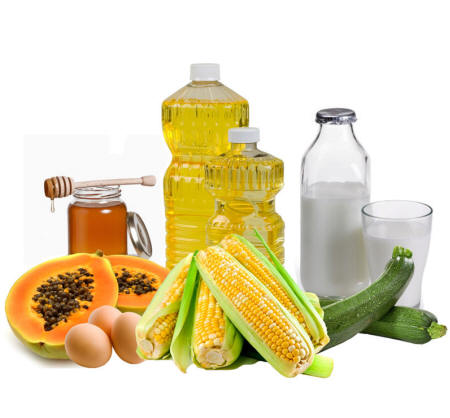|

2012
from
NonGMOProject Website

GMOs, or "genetically modified
organisms," are plants or animals created through the gene splicing
techniques of biotechnology (also called genetic engineering, or
GE).
This experimental technology merges DNA
from different species, creating unstable combinations of plant,
animal, bacterial and viral genes that cannot occur in nature or in
traditional crossbreeding.
For consumers, it can be difficult to stay up-to-date on food
ingredients that are at-risk of being genetically modified, as the
list of at-risk agricultural ingredients is frequently changing.
As part of the Non-GMO Projectís
commitment to informed consumer choice, we work diligently to
maintain an accurate list of risk ingredients.
Agricultural products are segmented into two groups:
-
those that are high-risk of
being GMO because they are currently in commercial
production
-
those that have a monitored risk
because suspected or known incidents of contamination have
occurred and/or the crops have genetically modified
relatives in commercial production with which
cross-pollination (and consequently contamination) is
possible
For more information on the Non-GMO
Projectís testing and verification of risk ingredients and processed
foods, please see the
Non-GMO Project Standard.
High-Risk Crops,
...in commercial production;
ingredients derived from these must be tested every time prior
to use in Non-GMO Project Verified products (as of December
2011):
-
Alfalfa (first planting
2011)
-
Canola (approx. 90% of U.S.
crop)
-
Corn (approx. 88% of U.S.
crop in 2011)
-
Cotton (approx. 90% of U.S.
crop in 2011)
-
Papaya (most of Hawaiian
crop; approximately 988 acres)
-
Soy (approx. 94% of U.S.
crop in 2011)
-
Sugar Beets (approx. 95% of
U.S. crop in 2010)
-
Zucchini and Yellow Summer
Squash (approx. 25,000 acres)
ALSO high-risk:
-
animal products (milk, meat,
eggs, honey, etc.) because of contamination in feed.
Monitored Crops,
...those for which suspected or
known incidents of contamination have occurred, and those crops
which have genetically modified relatives in commercial
production with which cross-pollination is possible; we test
regularly to assess risk, and move to "High-Risk" category for
ongoing testing if we see contamination:
-
Beta vulgaris (e.g., chard,
table beets)
-
Brassica napa (e.g.,
rutabaga, Siberian kale)
-
Brassica rapa (e.g., bok
choy, mizuna, Chinese cabbage, turnip, rapini, tatsoi)
-
Curcubita (acorn squash,
delicata squash, patty pan)
-
Flax
-
Rice
-
Wheat
Common Ingredients Derived from GMO Risk
Crops:
-
Amino Acids
-
Aspartame
-
Ascorbic Acid
-
Sodium Ascorbate
-
Vitamin C
-
Citric Acid
-
Sodium Citrate
-
Ethanol
-
Flavorings ("natural" and
"artificial")
-
High-Fructose Corn Syrup
-
Hydrolyzed Vegetable Protein
-
Lactic Acid
-
Maltodextrins
-
Molasses
-
Monosodium Glutamate
-
Sucrose
-
Textured Vegetable Protein (TVP)
-
Xanthan Gum
-
Vitamins
-
Yeast Products
You may also be wondering aboutÖ
-
Tomatoes:
In 1994, genetically
modified Flavr Savr tomatoes became the first
commercially produced GMOs. They were brought out of
production just a few years later, in 1997, due to
problems with flavor and ability to hold up in shipping.
There are no genetically engineered tomatoes in
commercial production, and tomatoes are considered
"low-risk" by the Non-GMO Project Standard.
-
Potatoes:
Genetically modified NewLeaf
potatoes were introduced
by Monsanto in 1996.
Due to consumer rejection by several fast-food chains
and chip makers, the product was never successful and
was discontinued in the spring of 2001. There are no
genetically engineered potatoes in commercial
production, and potatoes are considered "low-risk" by
the Non-GMO Project Standard.
-
Salmon:
A company called AquaBounty
is currently petitioning the FDA to approve its
genetically engineered variety of salmon, which has met
with fierce consumer resistance. Find out more
here.
-
Pigs:
A genetically engineered
variety of pig, called
Enviropig was developed
by scientists at the University of Guelph, with research
starting in 1995 and government approval sought
beginning in 2009. In 2012 the University announced an
end to the Enviropig program, and the pigs themselves
were euthanized in June 2012.
|

